Ecommerce is a constantly changing industry with rapidly evolving technologies, trends, and a competitive environment. No wonder the recent pandemic was a serious game-changer for this niche, bringing both positive and negative effects for all businesses in this sector. During the lockdown, consumers completely changed their way of purchasing goods, forcing companies to invest in ecommerce channels and digital marketing.
According to Shopify, more than 150 million people made their first purchases online in 2020. France, Canada, Australia, the UK, and a number of other countries experienced a massive boom of online shoppers. Up to 6% of consumers from these countries shopped on the Internet for the first time.
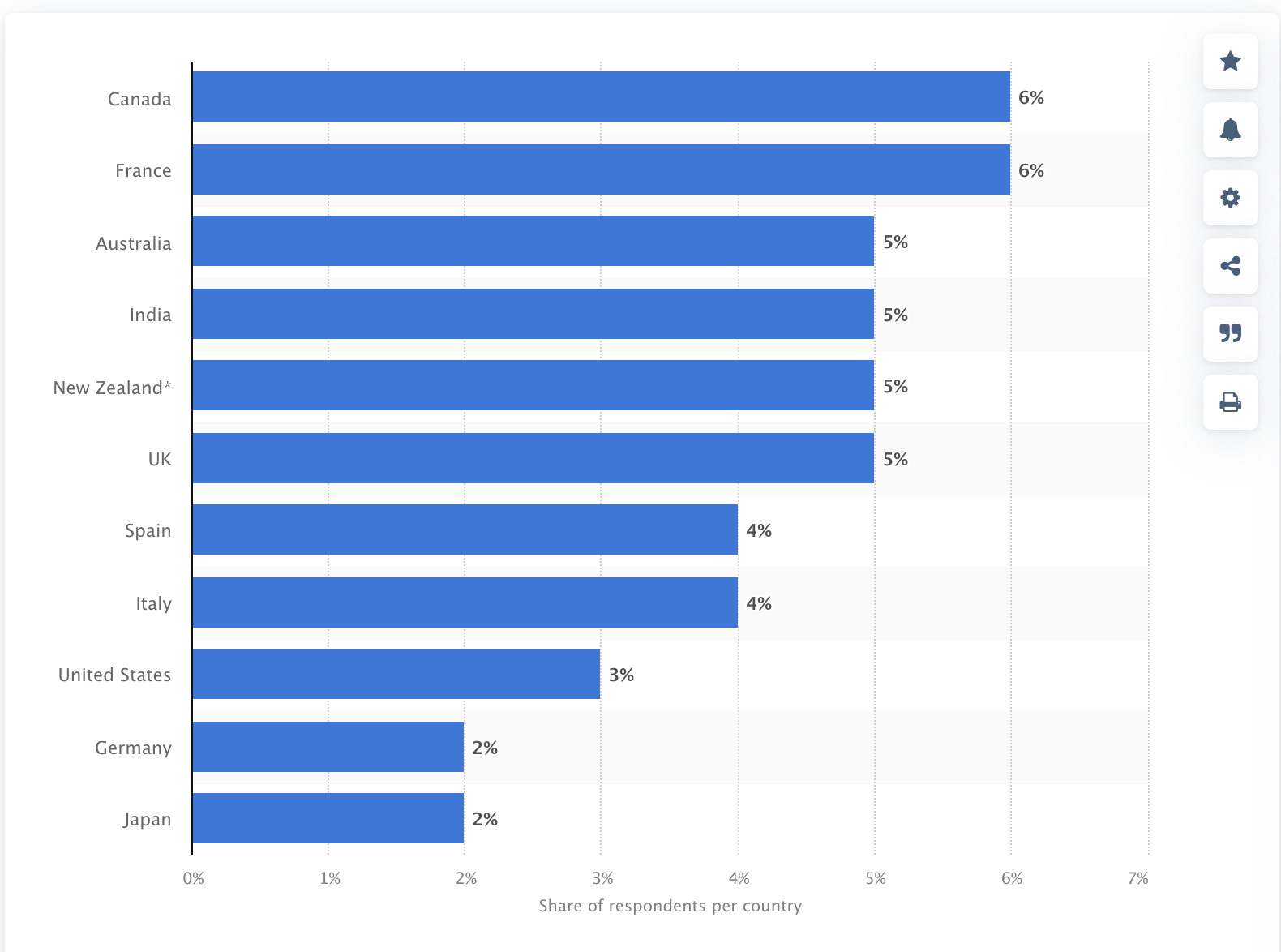
Such a rapid surge in new customers led to the appearance of new brands, the development of technologies, and an increase in companies’ compound annual growth rate (CAGR).
💡 The compound annual growth rate (CAGR) is the rate of return (RoR) that would be required for an investment to grow from its beginning balance to its ending balance, assuming the profits were reinvested at the end of each period of the investment’s life span.
Since the beginning of the pandemic, the US ecommerce industry revenue skyrocketed from $360 million in 2019 to $469 million in 2021. Moreover, it’s expected to reach $563 million by the end of 2025 — quite a rise for such a short period.
However, these hard times also had a negative impact on the industry. For example, the coronavirus disrupted the supply chain industry. Thus, almost 35% of business owners stated that delivery delays led to numerous refunds and, as a result, significant losses.
In this article, we’ll highlight challenges, and determine the major ecommerce trends for 2025. Keep an eye on them when developing your ecommerce business strategy, so you’re well prepared for what’s waiting ahead.
The Review of Ecommerce Challenges in 2025
Despite the overall rise of the ecommerce industry, increase in CAGR, and other positive changes, the year 2025 is far from ideal.
The major issue of 2025 remains the same: the shipping crisis. According to CNN, the worldwide supply chain remains tangled and the situation isn’t getting any better. Companies have to spend more on deliveries, which might affect the cost of goods and the global sales volume. The World Container Index (a global indicator of container freight rates) shows that the price for a 40ft container is currently around $9,900. That’s 283% higher compared to the previous year.
Another global problem is that suppliers drastically jack up prices for goods. Bloomberg states that US consumers may expect a 4% inflation rate over the next three years. This is the highest rate since 2013. In recent months, suppliers raised their prices by 15%. Don’t forget to count the increased shipping rates. As a result, end consumers will pay more for the same quality goods, which may lead to decreased demand for products.
2021 is gunning hard for the title of worst year EVER in eCommerce.
— Andrew Youderian (@youderian) October 1, 2021
You're probably aware of the shipping crisis but there's three additional plagues that are making life miserable for the #ecommerce faithful.
(Full thread below with some telling stats 👇)
“Lots of emergency maneuvering, including cutting spend, fleeing to Google/TikTok/other options and new attribution tools to try to get a better sense of what’s working. Some things are modestly stemming the bleeding but it’s bad.” -- Andrew Youderian, founder of eCommerce Fuel.
Furthermore, Andrew says that it has become hard to recruit talent for eCommerce projects and other niches:
Plague #3 - You can't hire anyone. Less hard data but loads of anecdotes: applications dropping from 300->3, 50% of people not showing up for day 1, new employees hiding to avoid work. Not universal, but owners are dealing with staff problems they've never seen before.
— Andrew Youderian (@youderian) October 1, 2021
According to a study by Digital Commerce 360, US ecommerce growth slowed down in Q2 of 2021 compared to Q1 of 2021 and the whole of 2020.
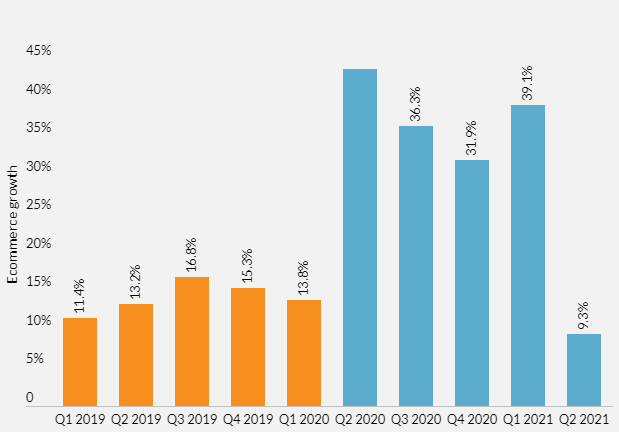
As you can see, the year was full of challenges and obstacles for the ecommerce industry. However, the niche is still growing, and there are many promising trends on the horizon.
12 Ecommerce Trends for 2025
So, what trends will disrupt the ecommerce industry in the near future and accelerate revenue growth for companies? With the development of new technologies and the appearance of new marketplaces, ecommerce brands have a lot of opportunities to explore. They can also experiment with new channels and apply new strategies. Let’s dive into the rising ecommerce trends for 2025.
1. Social Commerce Accelerates With New Players Coming Into the Niche
Social media platforms are part and parcel of our everyday lives. Both ecommerce businesses and social platforms know it and collaborate toward creating mutually beneficial conditions for delivering products to customers. Today, social media platforms like Instagram, Facebook and TikTok have become discovery engines for brands. For example,
Facebook claims that 63% of online shoppers who use Facebook, use it for shopping activities.
Don Brett, global chief digital officer at NBG Home and notable ecommerce influencer, shared a summary of Kantar’s report on the state of the ecommerce industry. Their insights on the biggest ecommerce opportunities prove that social commerce is going to be one of the most promising ecommerce trends in the near future.
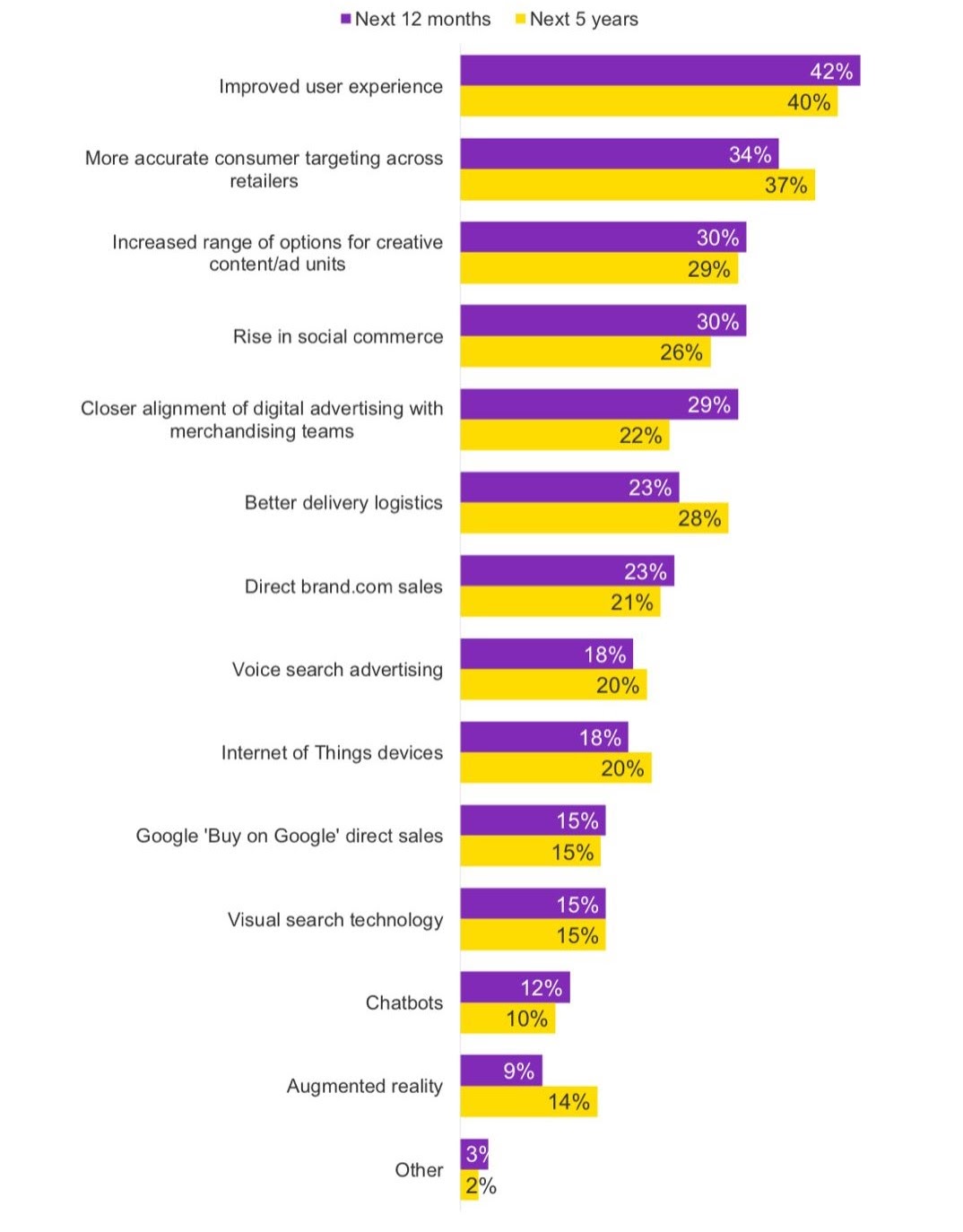
Recently, TikTok rolled out its pilot TikTok Shopping feature in the US, Canada, and the UK. This is a new milestone for social commerce. Around 60% of TikTok users are generation Z, with an “I like it, I buy it” mentality. With fast fashion being so popular among Gen Z and ever-growing spending on beauty, we expect more fashion brands to appear on TikTok. No wonder Kylie Cosmetics was among the first brands to adopt TikTok Shopping.
Jason Wang, the founder and CEO of Dou Lashes, an eight-figure ecommerce brand, says that social commerce helps brands serve customers who don’t waste too much time on browsing product pages and reading copy.
“There are two buckets of people who like to browse on our website. Number one is people who really want to go through the entire experience from the homepage to the product page and read all the copy. And there are people who want to see a product, add it to a cart, and check out in five seconds. And for us, Instagram Shop was the only product at the time to enable that. At this point, Instagram makes up around 38% of our total revenue.” -- Jason Wang, founder and CEO of Dou Lashes.
Social commerce goes hand in hand with social media marketing and generates tons of useful insights into your potential customers and target audiences. Three out of four companies have experienced a growth in customer engagement due to analysis of customer behavior and data-driven marketing. However, 35% of marketers claim that it’s hard to maintain data quality during all operations, and 26% of analysts experience difficulties with data standardization.
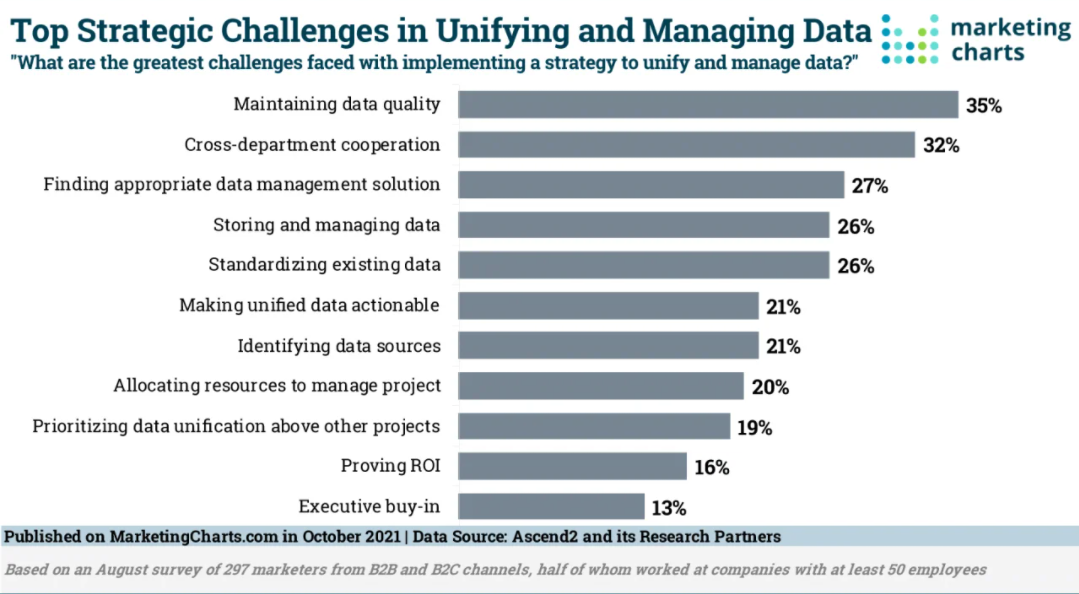
Retail, ecommerce, and companies from other sectors use ETL solutions to unify social media marketing and sales data. These platforms help extract and normalize data from any social media platform. Later on, you can push analysis-ready insights to any data warehouse and get actionable insights in the BI tool of your choice. Tools may differ depending on the size of your company. For example, Improvado is a great choice for large ecommerce businesses, while Supermetrics is a practical alternative for small shops with a small number of marketing data sources.
Here’s what Jeff Lee, head of social and marketing data at Asus, says about Improvado:
“Previously, we couldn’t get reports from different locations on time and in the same format, so it took days to standardize them. Today, we can finally build any report we want in minutes due to the vast number of data connectors and rich granularity. One more thing is that now we don’t have to involve our technical team in the reporting part at all.”
Improvado Helps ASUS Take Full Control Of Their Global Marketing Data
2. Personalized Offering Builds Brand Loyalty
Gathering cross-channel data about your customers to offer personalized experiences is a great way to differentiate your ecommerce brand from competitors in 2022. Research by Accenture states that 91% of consumers are more likely to interact with brands that know customers’ preferences and provide unique, individualized offerings.
A simple Thank You email can add a ton of value
It’s a good idea to add a personal touch to your communication with clients. Sending a personalized thank you letter doesn’t only show respect and appreciation but also provides new opportunities for future sales. Thank you emails have a 67% open rate and a 6.3% click-through rate. That’s a 352% higher open rate and 329% higher CTR compared to regular email campaigns. Thus, you can offer related products, provide discounts, and simply thank your customers and rest assured that they will see your message.
Neverending ways to improve the CTR of your pages
To improve the CTR on your product pages, you can display the top-rated goods related to customers’ target categories. Popular products always attract more attention because users want to know what is in demand today and why the product is on the rise. For this purpose, you’ll need a well-designed recommendation algorithm to understand your customers’ interests and preferences.
For more information about conversion rate optimization and customer acquisition, check out this guide by BigCommerce.
3. Ecommerce Platform Optimization Influences Online Visibility
Having an optimized website is crucial for a company’s visibility and search engine rankings—especially when it comes to ecommerce platforms, be it a headless commerce platform or another one, that sometimes have millions of product listings, various images, and other heavyweight elements. The need for website optimization is proven and well-documented.
Mobile page load time magic
For example, Swappie, an ecommerce platform that distributes refurbished mobile phones, increased its revenue by 42% by optimizing its mobile page load time.
By the way, here’s a useful template that you can use to track and optimize your own mobile page load time.
There are a ton of tools that will help you to identify the weak points of your website. With Google PageSpeed Insights, you can always keep an eye on your website performance.
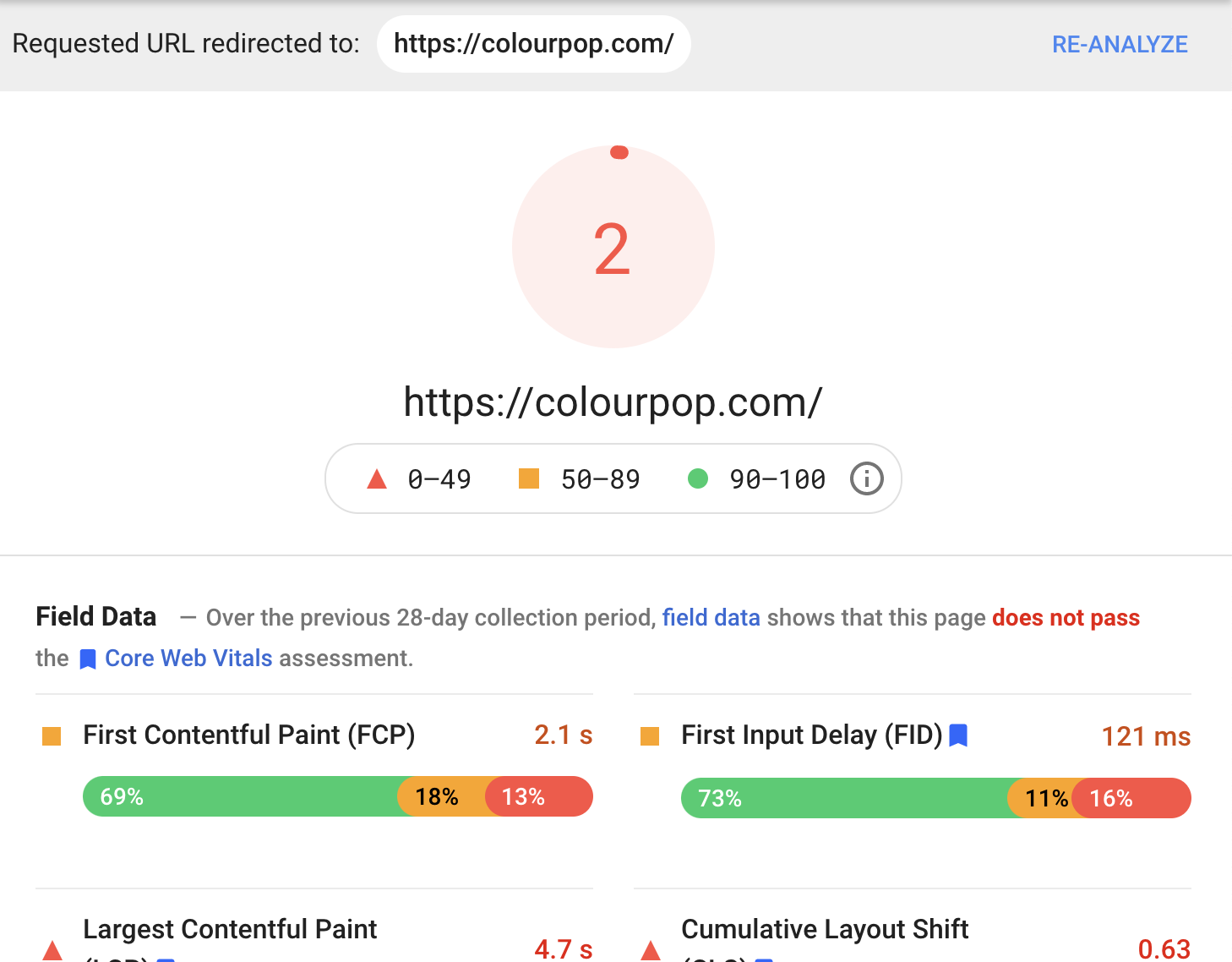
Bigger is not always better
Another point to look out for is the image size. Before uploading any images, you should compress them for the sake of load time and optimization. Services like TinyJPG or ShortPixel can significantly reduce the size of your image for free. By compressing RAW image files, you can decrease their size by 70% without noticeable quality degradation.
Loading techniques play a vital role in page speed optimization. For example, with a technique called lazy loading, the website loads only images that are initially shown to users. Off-screen images will be loaded later on if needed. This decreases the page load time significantly.

4. Creative Advertising Helps to Capture the Audience’s Attention
Attracting prospects’ attention becomes hard with plain ads, banners, and creatives. To stand out among your competitors and generate more conversions, you have to get creative about the ads you use when reaching out to potential customers.
When it comes to organic traffic from search engines, ranking higher on SERP definitely brings you more leads. However, to make users click on your search engine positions, the position is not enough. You need a smart approach to your headlines. For example, Hubspot’s report on data-driven strategies for creative headlines shows that bracketed clarifications result in a 38% growth in CTR.
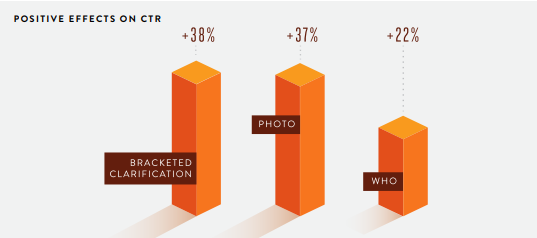
If you’re running PPC campaigns, your creatives should be clear, concise, and accurately explain the provided value. Remember that you’re paying for clicks, not for conversions. That means poorly adjusted campaigns or vague value propositions will force customers to click on the creative and then leave without making a purchase.
Take a look at Bloomberg’s creative that recently caught our eye. An expressive font, laconic copy, clear price, and a straightforward call to action. What else could you need?

Still, marketing doesn’t revolve around the digital environment only. Even though businesses reduced spending on out-of-home (OOH) advertising by 21.7% in 2020, the niche is expected to experience a 14.5% growth in 2021.
However, you have to spend the OOH budget wisely. Attractive visuals, compelling copy, or even memes can arouse interest across your prospects. Out-of-home ads have the smallest cost to reach the audience, which is around $3.38–$8.65 per thousand impressions. That means you can experiment with different styles and messaging.
Here’s how Weezy, a London-based grocery delivery app, approaches outdoor advertising.

The great font choice and amusing copy are what makes these ads so catchy.

5. Rapid Customer Research as a Way to Keep Up With Customers’ Needs
In times of uncertainty, it’s harder than ever to identify and keep up with customers’ ever-changing needs and preferences. It would be unreasonable to rely on pre-COVID insights on customer behavior because a lot of new clients moved to online shopping, so they still don’t have a settled shopping pattern and interaction model with ecommerce brands.
Moreover, trends such as fast fashion bring even more uncertainty to consumers’ preferences. Trending products may change every month, so it’s hard to predict what goods will be on the rise for the next year, or even the next quarter. That’s why rapid customer research will definitely be a crucial ecommerce trend in 2025.
Instead of focusing on the time-consuming analysis of customers’ needs, conducting a proof of concept, and drawing up reports, companies should test their drafts and guesses to understand what further steps will drive more revenue.
In view of today’s market, iterative A/B testing and complex customer research aren’t the best tools. We’re not saying that overlooking target group research is right. However, in today’s reality, ecommerce brands should be dynamic and follow consumer trends. And rapid customer research is a tool that will be around for a while.

6. Augmented Reality Brings New Customer Experiences
Augmented reality is another rising ecommerce trend that pushes customers toward a buying decision. During the global lockdown, it was essential for businesses to provide clients with in-store experiences without leaving the comfort of their homes. With AR in retail, users have more opportunities to search for new products, compare, try them on, and make purchases.
Azad Abbasi, CEO at Genius XR, a VR and AR content creation and development company, says that AR opens a new era for ecommerce and retail.
“Now that AR has reached such impressive levels, we are now able to preview products through our phones or tablets in a way that makes it seem as if we are right there touching them.
For example, say you are considering buying a new bicycle. With AR, it would now be possible to preview it at full scale and take a look at every angle, from any perspective you want, and really look closely at all the details.”
It’s not a surprise that AR will be a booming trend as a lot of industry giants utilize this technology. For example, Nike developed an AR app that precisely measures the user’s feet and outputs the shoe size. IKEA developed another notable AR application that allows users to try on furniture and interior objects inside their houses with AR. The list goes on, and it’s possible that we’ll see more and more use of this technology in the ecommerce niche.
“I predict that AR will become a normal way to shop in every store in the next five to ten years, without a doubt. This means that those who get involved in the next few years are the ones who will likely benefit the most,” says Azad Abbasi.
7. Supply Chain Optimization is More Crucial Than Ever Before
As mentioned before, ecommerce companies experience significant issues with supply chain management and lose money because of poorly timed deliveries. On a grander scale, there’s nothing that companies can do with increased rates and delays because everything comes down to a global shipping clutter. However, optimizing the supply chain at a company level may decrease the ETA of deliveries and improve user experience.
According to Invesp, 57% of businesses have poor visibility across their supply chain. This means companies can’t see stumbling blocks across delivery routes and improve their shipping processes. Moreover, it’s likely that customers also can’t track their deliveries during the shipping process, get incorrect ETA, and wait for their goods longer than expected. Obviously, this leads to deterioration of customer experience and decreases in brand loyalty.
If the crisis passes, we’ll see more improvements in the logistics sectors. Warehouse optimization, implementation of supply chain management software, and expansion of the companies’ supply chains will be a must in 2025 for every ecommerce company.
8. Subscription Models Helping to Retain Clients
Subscription-based revenue models show great results if entrepreneurs choose a relevant niche. There are hundreds of successful examples in entertainment (Spotify, Netflix), SaaS (Atlassian, Zendesk), EdTech (Coursera), and many other industries. However, the subscription trend in ecommerce is yet to be established. What exactly can this strategy bring to businesses?
One of the main problems in ecommerce is a very low customer retention rate compared to other verticals. According to MoEngage, the average customer retention rate in ecommerce is only 38%.
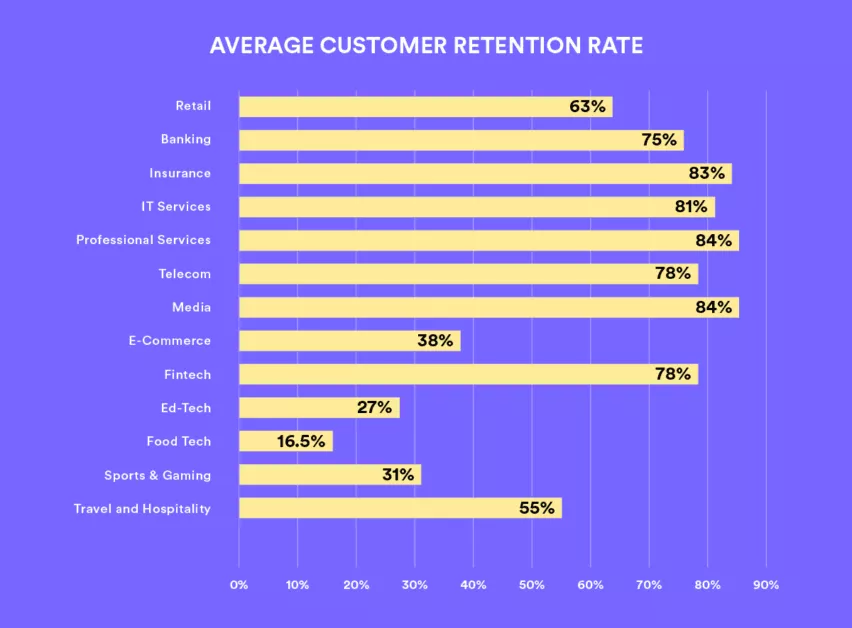
It’s no wonder that the rate is low when the ecommerce industry is so highly competitive. After the first purchase, customers may never return to your ecommerce platform. They may find one with better deals, faster deliveries, better customer service, or something else. Considering that there are hundreds of competitors, it may be hard to keep an eye on each of their prices and promotions.
Subscription-based models work great if you need to make clients stick to your brand for longer and establish brand loyalty.
Parsa Saljoughian, VP of strategic finance at WHOOP states that subscription-based businesses retain up to 65% of their customers in a 12-month period.
“The best subscription businesses retain 65%+ of their revenue after one year. Retention above 50% is considered in the top quartile, and 42% is the median. Many companies hover between 40–45%.”

Under the subscription model, ecommerce businesses can provide various benefits, such as:
- Free or discounted shipping
- Exclusive discounts for selected products
- Special occasion benefits (birthday, company anniversary, etc.)
- Exclusive loyalty programs
- Early access to new products
Besides, with a subscription model, businesses can help customers restock consumable products automatically. It may be useful for B2C, as well as for B2B. For example, Dollar Shave Club offers a replenishment subscription and may supply barbershops or beauty shops with razors, toiletries, and so on.
The subscription applies to food and groceries. Both businesses and regular consumers may need to restock groceries on a permanent basis. A replenishment subscription is a convenient way to keep products in stock without having to browse through ecommerce platforms each time you need to make an order.
Even though there are different subscription terms, businesses tend to transfer all clients to a year-long subscription. Having paid once for the entire year gets customers used to the benefits provided by the ecommerce platform. Moreover, if the company offers free shipping, customers may potentially place more orders to get an ROI on their subscription purchase.
So, subscriptions bring evident benefits to ecommerce businesses, and this model will definitely be a rising ecommerce trend in 2025.
9. Ecommerce Brands Build Trust With Clients With a DTC Model
Modern customers aren’t only looking for the fulfillment of their consumer needs. Today, shoppers also tend to explore brand stories and establish bonds with companies.
Selling your product via gigantic platforms like Amazon or Walmart might be effective in the short term. However, it’s hard to explain the story of your company, the features of your product, and the effort you’re putting into it while being yet another listing in a tremendous ecosystem.
The direct-to-consumer approach is here to change everything. If you are a manufacturer or have some kind of product, make the website your main distribution channel. In the digital space, your website is the face of your business. It allows you to tell stories, explain the product’s value, and increase brand visibility.
Let’s take a look at Gymshark, a UK-based fitness apparel manufacturer. The company used the DTC (direct to consumer) model and built a group of passionate fitness enthusiasts around their brand. Gymshark was launched in 2012 and reached a turnover of £260.6 million in 2020. A colossal success for such a short period.
Gymshark applied influencer marketing, organized events on Facebook, and increased brand awareness by all means possible. However, such an uplift would be impossible if the company had chosen to get lost in endless Amazon listings. Due to the founder’s fitness passion, brand story, and well-thought-out marketing strategy, the brand has shown incredible results.
By the way, Improvado also contributed to Gymshark’s growth by helping them arrange their marketing data. Learn more about our collaboration.
Besides, you don’t need much to start a shop. Solutions like Shopify allow you to create your own online store without serious hassle. All you need are an outstanding product and a brand image that attracts customers.
10. Omnichannel Strategy to Connect With More Prospects
Even though distributing your products only via Amazon isn’t a good idea from a brand awareness perspective, it’s still a good way to increase your revenue. The more platforms you target, the more clients you’ll attract.
Omnichannel retail implies distributing your goods over different channels, such as social media, marketplaces, brick-and-mortar stores, and other options. Placing products on all popular platforms certainly impacts their visibility across the Internet. According to data gathered by Google, omnichannel strategies drive 80% more incremental store visits.
Here’s what eMarketer says about omnichannel ecommerce perspectives.
“Forecasters expect multichannel sales to make up close to 46% of all ecommerce sales by 2023, up from 40.3% in 2019. That said, nonstore retailers will still dominate over 54% of the market, with sales approaching $687 billion.”
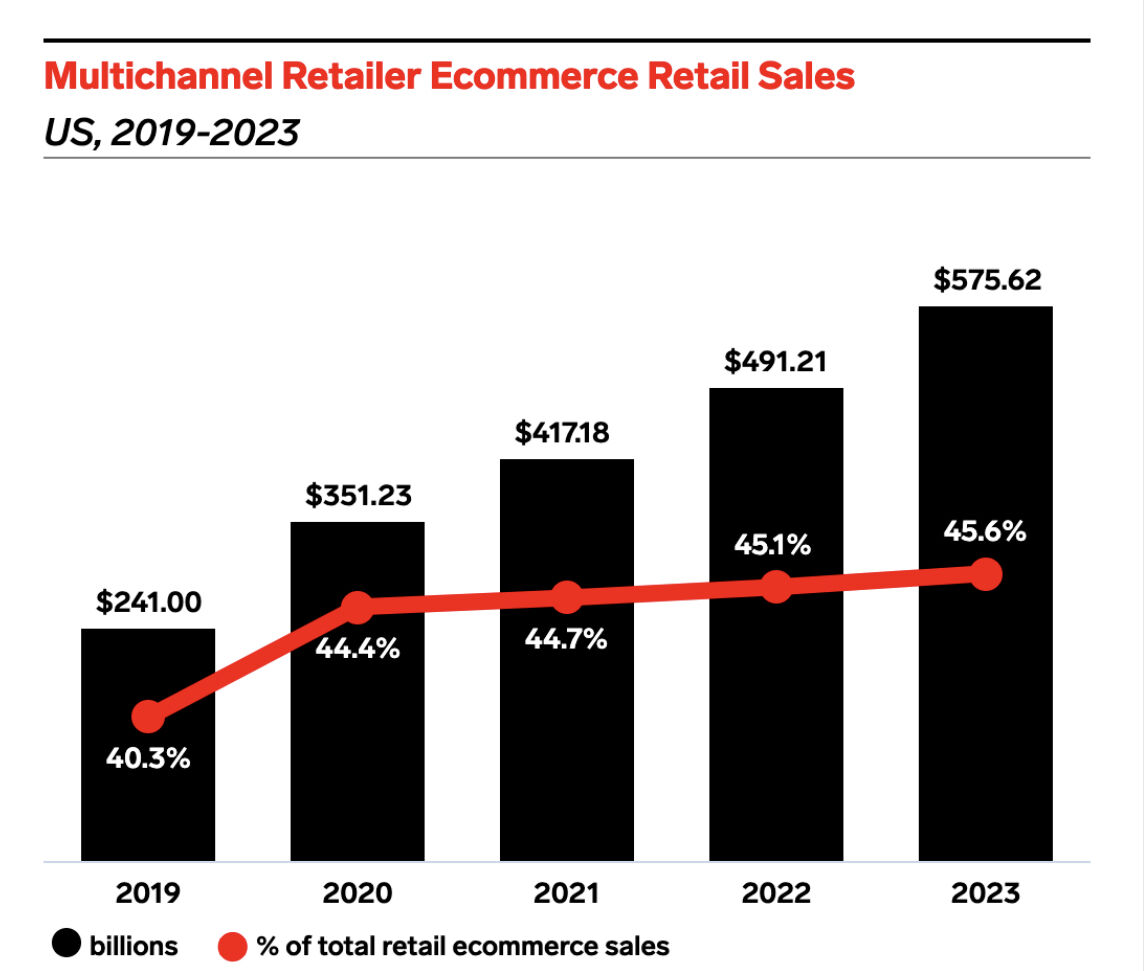
Besides, the intelligence company forecasts a decrease in the percentage of total retail sales generated by nonstore retailers.
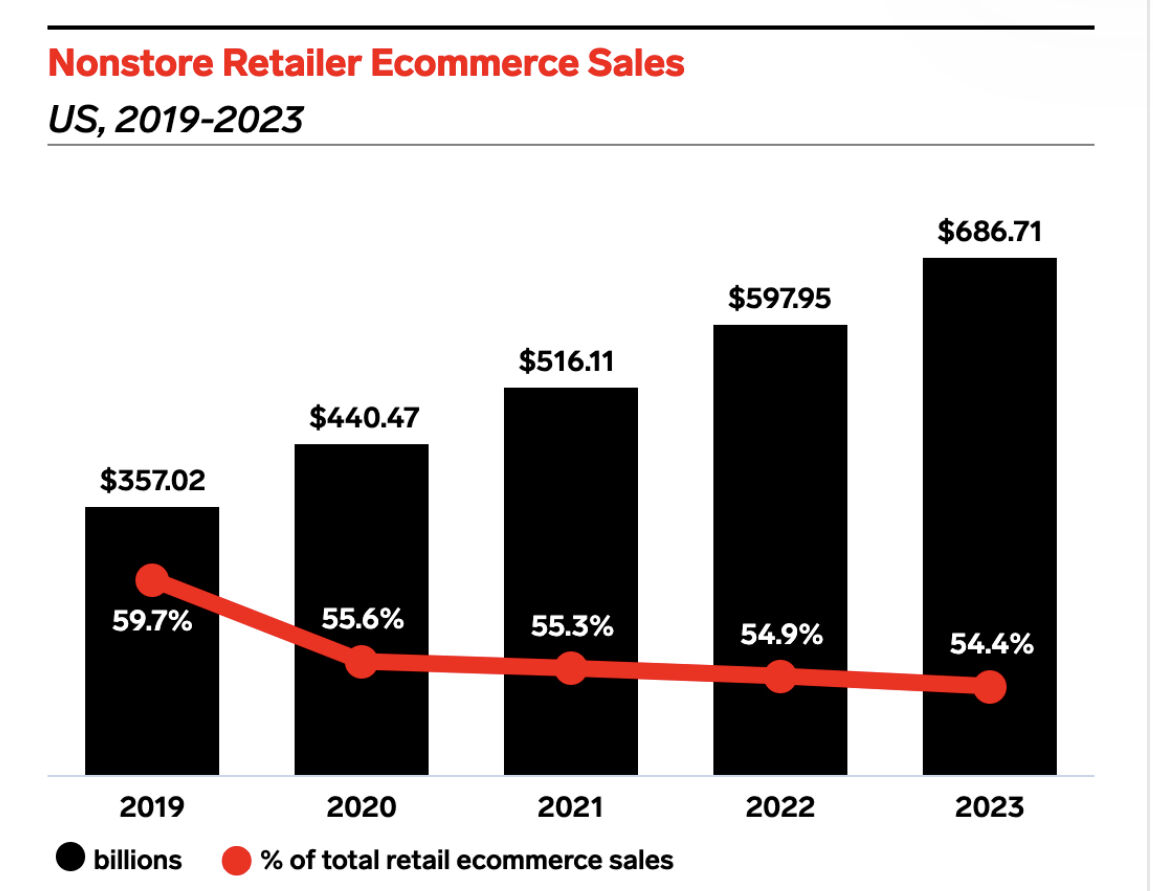
11. Privacy Issues Lead to Increased Acquisition Cost
Ecommerce businesses will face new prices for customer acquisition and experience issues with attracting new customers. A recent privacy update introduced by Apple in iOS 14.5 allows all iPhone users to opt out of data tracking. Only 15% of users worldwide and 6% of US users opted in for app tracking after the update.
This immediately led to an increase in the user acquisition cost of personalized ads and decreased the ROI of the overall advertising spend. For example, Ian Sigalow, co-founder of Greycroft, shared insightful statistics in his recent tweet.
When Apple disabled mobile-app tracking, privacy advocates cheered because $FB (+others) can't see as much data.
— Ian Sigalow (@Sigalow) October 20, 2021
6 months later, app acquisition costs increased 10x. Advertising doesn't perform w/o targeting.$FB will be OK, but this inefficiency is a $50B/yr tax on the economy
At the same time, Apple’s privacy policies limited competitors and caused Apple’s own ad network to thrive. This chart by @andrewparker clearly shows the rapid growth of Apple Search Ads over the last few months.
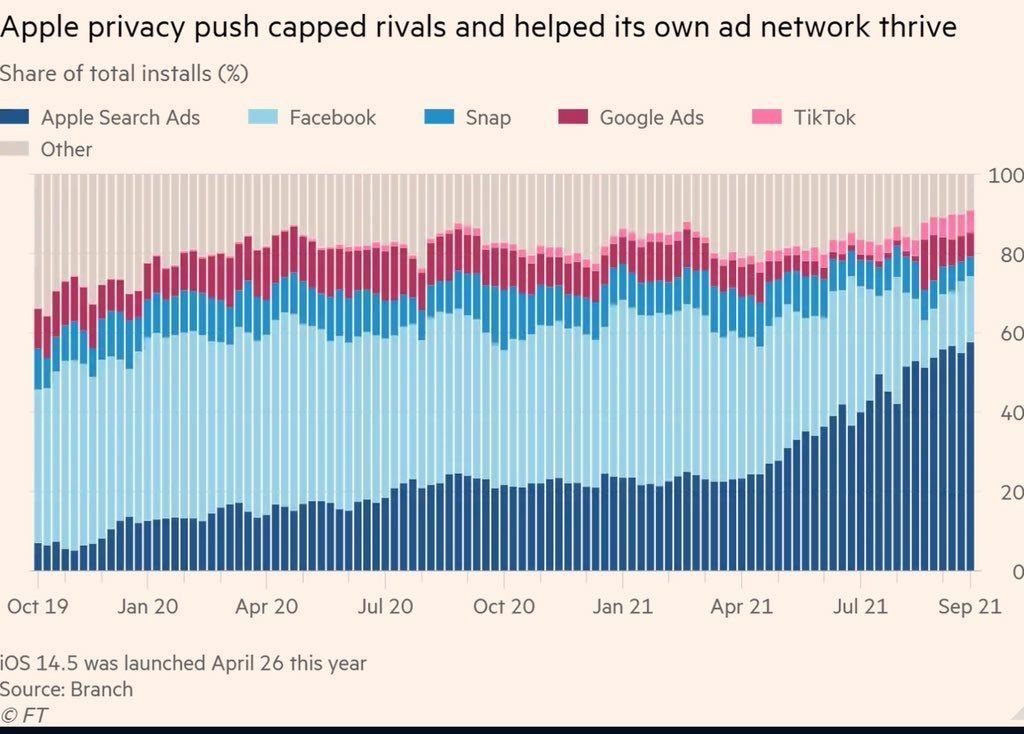
The privacy update has prompted controversial opinions from marketers and entrepreneurs. But it’s clear that with the rising cost of acquisition, companies, especially SMBs, will face difficulties in attracting new clients. Money and time are the two main resources that ecommerce startups lack. Such changes in marketing spend may negatively impact their growth and profitability. Here’s what Apoorva Govind, founder of Bestever and former senior software engineer at Uber, thinks of the situation:
Yep. Our SM brands are all struggling to acquire users. I think the second-order effect of this going to be that, there won't be as many DTC brands anymore. We will probably see the come-back of conglomerates and fewer indy brands
— Apoorva Govind (@Appyg99) October 20, 2021
On the other hand, there are prominent examples of when companies cut their performance marketing expenses and saw virtually no changes in sales and revenue. Here’s an article by Forbes that shows us real-world examples of how companies successfully decreased their ad spend without a noticeable impact on business.
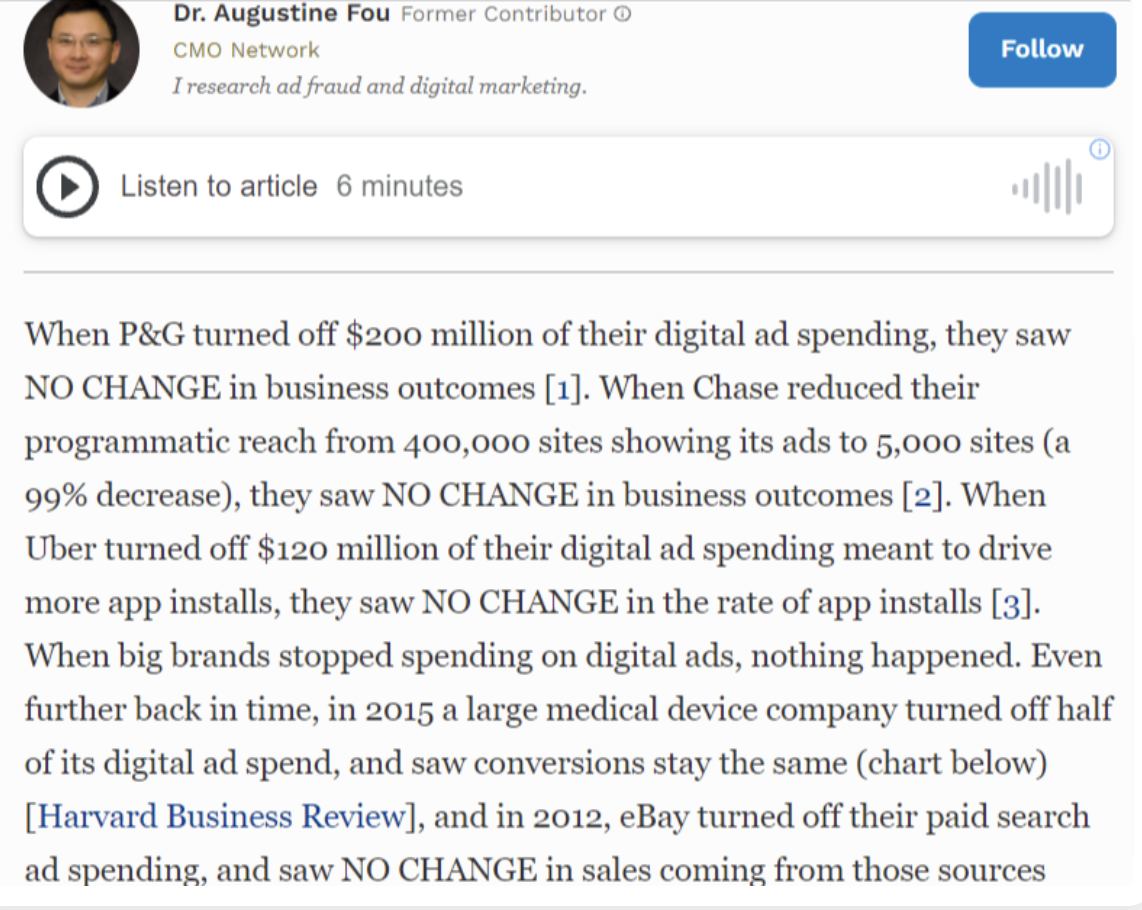
It seems like brands may reallocate their marketing spend to other channels, like influencer marketing, affiliate, or referral channels. Still, attribution isn’t going anywhere; it may just slightly slow down. By the way, here’s our extensive guide on creating an attribution model.
12. Multiple Payment Options Influence Shopping Cart Abandonment Rate
The final trend on our list concerns payment options. Ecommerce and retail companies that offer customers multiple payment options are more likely to increase their conversion rate and improve customer satisfaction.
In 2021, the global retail shopping cart abandonment rate reached 75.6%. There are numerous reasons for this, like long delivery times, slow loading, security issues, and so on.
The absence of the required payment options is one of the reasons why potential customers leave right before the conversion.
With a rising number of payment methods, it’s vital for businesses to provide their customers with flexibility. In order to boost sales with new payment options, companies should understand what methods their audience uses. In a report by PaySafe, we found an interesting chart.

It clearly states that Gen Z shoppers use more diversified payment options than Gen X. So, conducting audience research is vital before implementing new payment methods.
We can highlight the following payment methods as the most popular for today:
- Google Pay
- Apple Wallet
- PayPal
- Payoneer
- Credit cards (both traditional and contactless)
- Stripe
- Cryptocurrencies (Bitcoin, Ethereum, etc.)
So, this ecommerce trend will bring certain benefits with well-thought-out audience research.
Our Forecasts
In this extensive guide on the upcoming ecommerce trends, we’ve pointed out the most important strategies that might help online retailers drive revenue.
We didn’t emphasize marketing, sales process optimization, customer care, ecommerce analytics, and other fundamentals. That’s because these elements aren’t trends—they are a necessity in today’s world.
Companies that achieved what we call the “ideal state of analytics” will have more chances to jump ahead of the competition.
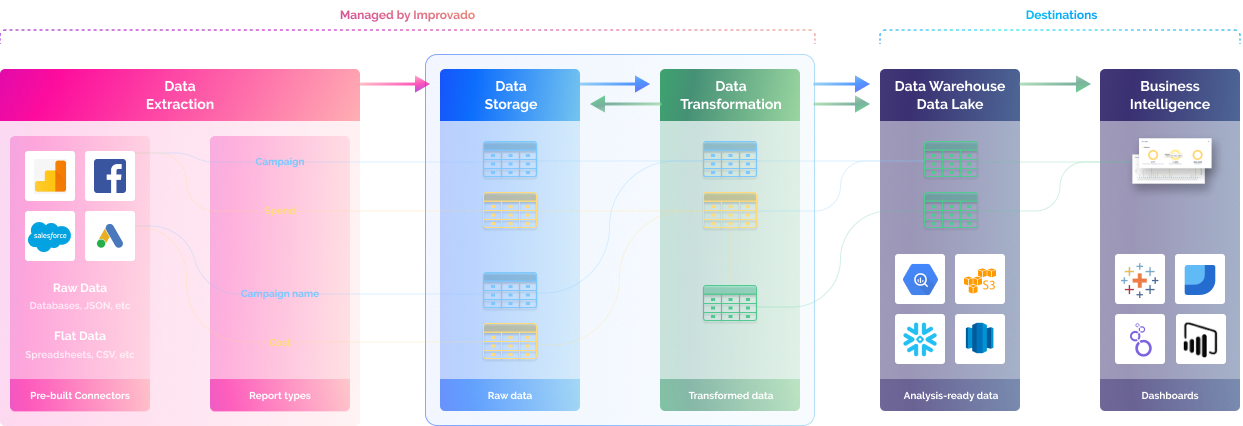
We believe that gathering insightful information about your customers, analyzing it, and then visualizing it still remains one of the “musts” in business. With constantly changing customer behavior and preferences, companies should collect and analyze all possible data to predict upcoming changes. The success of your future marketing campaigns, sales volumes, and overall development vectors depend on the forecasts and decisions that companies make here and now.
With so many data sources, it becomes hard to keep an eye on all data generated by every channel. That’s why businesses should search for data assistants that facilitate data operations and take the load off analysts.
Improvado may help ecommerce companies consolidate marketing insights from all data sources, normalize them, and then arrange them in a dedicated warehouse.
Get a demo to learn how companies optimize data processes and get a granular vision of their marketing campaigns with Improvado.
.png)
.jpeg)




.png)
